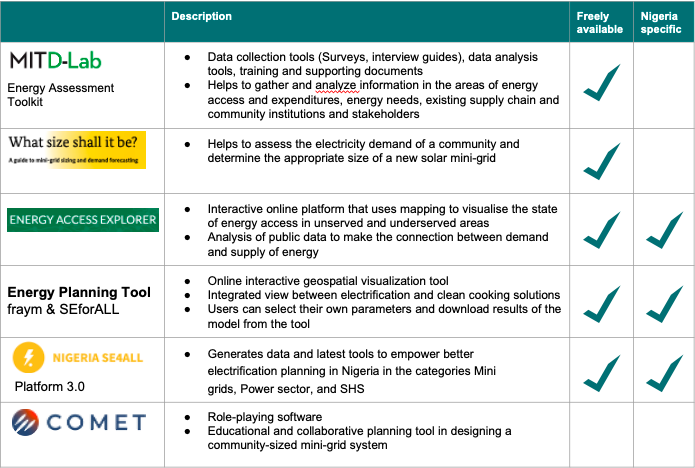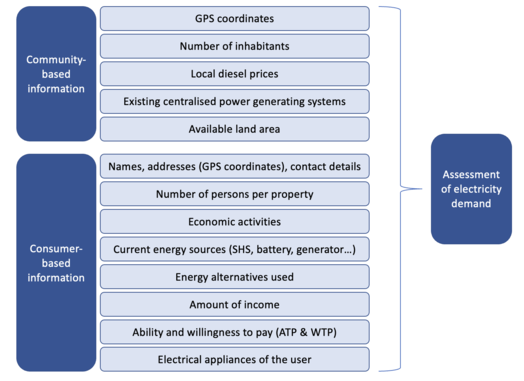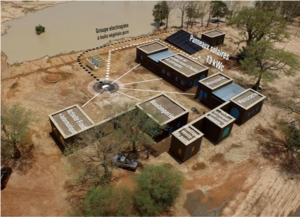Knowledge fuels change
For over a decade, Energypedia has shared free, reliable energy expertise with the world.
We’re now facing a serious funding gap.
Help keep this platform alive — your donation, big or small, truly matters!
Thank you for your support
Estimate and Stimulate Demand
Introduction
Estimating present and future electricity demand of different customer segments is central to the design and implementation of sustainable electrification interventions. Demand assessment is a key input in technical and business model design, and the accuracy of its results directly affects the size and financial feasibility of the project[1][2]. This section will focus on electricity demand estimation and stimulation for rural settings, where it is especially hard to make accurate predictions as many communities have never had access to electricity. First, definitions of present, assessed and (future) effective demand and load profiles are provided. Second, guiding principles give contextual information on the various aspects that are important to consider to accurately determine electricity demand. Last, existing tools and resources in the area of demand estimation are listed and briefly explained.
Definitions
Present electricity demand
The present electricity demand is the electrical energy consumed by all inhabitants at the time of the site visit. Where the community is not yet electrified, the present electricity demand is zero.
Assessed electricity demand
The assessed electricity demand is the amount of electricity that customers state they would use if there was electricity at this moment. It can be assessed by conducting surveys on site.
(Future) effective electricity demand
Effective electricity demand is the demand that is backed by financial resources and can actually be paid by the consumer. It is influenced by the willingness to pay (WTP) and ability to pay (ATP). The future effective electricity demand describes demand in future years which can be estimated by using socio-economic development factors. Assessing future demand and the growth potential is most challenging but very important as a mini-grid that can meet increased demand over time is more financially sustainable[3].
Electrical load profiles
The electrical load profile is the electrical load on a certain time axis, which varies according to customer type, temperature and seasonal effects. An average daily load profile gives insights on the peak load in kW which is required for the load forecasting and plant sizing and the energy demand in kWh to forecast demand and revenues. Aggregating the load profiles of all customers of the same class will result in the average daily load profile per consumer category and aggregating the load profiles of all consumer categories results in the average daily load profile in kW of the whole village.
Guiding Principles
Consider all factors that determine electricity demand
Figure 1 shows an overview of the various factors that have to be considered to most accurately estimate electricity demand. The community-based information can be assessed during a visit to the project location while the consumer-based information can be gained via on site surveys. Fig. 1: Important factors to estimate demand (Own illustration based on Blechinger et al., 2016[1])Adjust to local conditions and include the local community
To get first insights about current and future electricity demand for households or a community, it can be useful to take existing data from geographical and socio-economic comparable regions. However, for a more accurate demand assessment which is essential for a viable electrification intervention, an analysis of local conditions is inevitable. This goes hand in hand with including the local community and their needs. Users’ indications on their current electrical consumption and future needs are a key element in the design process of efficient off-grid systems. Involving locals at all project stages increases the chances of success for the project because satisfied users extend the viability of the system[1]. Hiring villagers who accompany the survey team during demand assessment enables the provision of local knowledge based input[3]. Another advantage of early stage inclusion is that local capacity building leads to increased skills on site and lowers the dependence on external know-how[1].
Efficient appliances are a relevant component in estimating demand
An increased level of complexity in demand estimation is the fact that off-grid solar products often do better and last longer when associated with efficient appliances[4]. This has important implications both for the demand estimates and the design of the business model. Developers should be aware of this uncertainty and integrate coping mechanisms in their business models. For example, the company CREEDS Energy raises awareness among its customers around energy efficient applications in order to increase the longevity and reliability of their SHS. Besides, the use of more efficient appliances can permanently reduce demand as less power is required for the same tasks[1].
Existing Tools and Resources
| Name | Nigeria specific | Open source | Description |
|---|---|---|---|
| PeopleSuN Demand database | Yes | Yes | The demand database within the PeopleSuN project was constructed by utilizing survey responses from 3,599 households and 1,122 enterprises. The survey included a set of questions specifically designed to ascertain the ownership of electrical appliances, as well as the timing of their usage during both the day and night. |
| MIT D-Lab Energy Assessment Toolkit (EAT) | No | Yes | The tool aims to gather and analyse data about current energy access and expenditures, aspirational energy needs, existing supply chain and community institutions and stakeholders via a community-based assessment approach. It targets any organisation that is locally present in an off-grid region and guides through the process of information gathering and informed decision making on the most suited technologies and business models to meet the specific community needs. The toolkit includes a series of open source surveys, interview guides, and data analysis tools. |
| Community Energy Toolkit (COMET) | No | No | COMET is a role-playing software tool built around a representation of a mini-grid system, intended to be used as an educational and collaborative planning tool in designing a community-sized mini-grid system. The tool is designed to be used within a process that explores mini-grid planning and operational decisions. After the simulation, one can generate reports and analyse data on consumer demand and payments.
|
| GIZ Guide "What size shall it be?" | No | Yes | The guide to mini-grid sizing and demand forecasting supports in assessing the electricity demand of a community and determining the appropriate size of a new solar mini-grid. The handbook is applicable to various geographical contexts where mini-grids can be implemented. Practical knowledge has been drawn from the authors’ experience in mini-grid implementation in sub-Saharan Africa.
|
| Energy Access Explorer (EAE) | Yes | Yes | The EAE is an interactive online platform that uses mapping to visualise the state of energy access in unserved and underserved areas. It analyses public data to make the connection between the demand and supply of energy so that users are able to identify and prioritise areas where energy markets can be expanded. |
| Fraym report 2018 by REA | Yes | Yes | The report provides an overview of different mini-grid and solar home system customer profiles to help practitioners estimate residential demand and willingness to pay. The data cover main lighting sources, generator ownership, electricity appliance household assets and the overall average household spending as well as on- and off-grid energy.
|
| Study “Off - and weak-grid solar appliance market Nigeria” | Yes | Yes | The study offers detailed insights in the markets of commonly used electricity appliances such as TVs, fans, refrigerators and solar water pumps. It informs on the common power type, product size, retail price, warranty and power consumption of each appliance sold in retail markets, as well as other findings relevant to sector stakeholders working in Nigeria. |
| Nigeria Integrated Energy Planning Tool | Yes | Yes | The tool is an online, interactive data visualisation platform that was developed by fraym in cooperation with SEforALL, under its Universal Integrated Energy Planning programme. It aims to support Nigerian policy makers and practitioners making more informed decisions in order to improve the country’s energy access. Once being registered, one can access and use the tool. |
| Nigeria SE4ALL Platform | Yes | Yes | The platform aims to generate the most accurate data and latest tools to empower better electrification planning in Nigeria. Data and tools can be found for the three categories (i) Mini grids, (ii) Power sector and (iii) SHS and are continuously updated. For example, the SHS section includes the app “Rural Solar Home System market analysis” which enables practitioners to explore rural off-grid communities that may be economically viable locations of SHS companies.
|
| Open Smart Meter | Yes | Yes | ENACCESS and First Electric created an open source GSM smart meter that meets IEC and key elements of the local regulations in Nigeria. The website includes hardware design, the web software as well as openly accessible firmware and directions, which are addressed to skilled personnal with software engineering knowledge. Smart meters are tracking the energy consumption of the customers and are therefore inevitable for developers. |

Within PeopleSuN, WP 2 provides quantitative survey data from 225 electrified non-urban villages across three Nigerian geopolitical zones as well as qualitative survey data from 8 electrified non-urban villages. Household and enterprise surveys were conducted.
The goals of the household survey are to
- Determining electricity consumption and expenditure and how it relates to electricity supply, and to
- Testing household preferences for appliances, electricity hour capacity, source and billing methods.
The goals of the enterprise surveys are to
- Defining typical enterprise types across non-urban Nigeria and develop improved estimates on their electricity needs, linking this with wealth and other factors, and to
- Testing enterprise preferences for appliances, electricity hours, capacity, source and billing methods.
The goals of the qualitative surveys are to
- Understanding which electric appliances are perceived as necessary for household wellbeing
- Understanding the socio-cultural values and norms related to use of electric appliances
- Understanding differences and similarities in values and preferences across population sub-groups (e.g. by gender)
The dataset includes answers from 3,599 households and 1,122 enterprises. It is freely available on Harvard Dataverse for all with attribution “RLI-PeopleSuN Energy Audits (RLI-PSN): Household and enterprise energy supply, use and preference data from rural Nigeria”.
WP3 will model appliance ownership and electricity consumption growth trends for households and enterprises. It will model available expenditures for electricity services and provide indication of “affordable” monthly service costs. Besides, normative “decent” energy needs for households and community services will be described.
Statistical models with stochastic algorithms are combined to generate distributions of likely electricity demand and expenditures. This is first conducted for the 225 enumeration areas that were visited and then extrapolated to all of non-urban Nigeria. The approach includes both pre-calculated electricity demand estimates (backend), as well as a tool for fully customisable stochastic demand modelling in any village (front-end). Different profiles are created per zone and per atlasAI wealth category, resulting in 10 different consumer categories/profiles.
The Preliminary Demand Assessment Model is a tool for project developers and policy makers to model and evaluate the demand requirement occurring in each consumer sector. The scope of the Model is reduced to the most important features, allowing for an easy entry of all key entry data, as well as giving sufficient feedback to fully understand and analyse the data in order to achieve maximum performance of the project. The use of this tool enables to characterise the electricity demand for different end-users within consumer segments, calculate the total power required per type of customer and the daily electricity consumption. As a result, the individual and aggregated daily load profile can be obtained and be extrapolated from a daily profile to weekly, monthly, annual and seasonal profiles.
The tool aims to gather and analyse data about current energy access and expenditures, aspirational energy needs, existing supply chain and community institutions and stakeholders via a community-based assessment approach. It targets any organisation that is locally present in an off-grid region and guides through the process of information gathering and informed decision making on the most suited technologies and business models to meet the specific community needs. The toolkit includes a series of open source surveys, interview guides, and data analysis tools[5].
- Community Energy Toolkit (COMET)
COMET is a role-playing software tool built around a representation of a mini-grid system, intended to be used as an educational and collaborative planning tool in designing a community-sized mini-grid system. The tool is designed to be used within a process that explores mini-grid planning and operational decisions. After the simulation, one can generate reports and analyse data on consumer demand and payments[6].
- GIZ Guide “What size shall it be?”
The guide to mini-grid sizing and demand forecasting “What size shall it be?”, published by GIZ, supports assessing the electricity demand of a community and determining the appropriate size of a new solar mini-grid. The handbook is applicable to various geographical contexts where mini-grids can be implemented. Practical knowledge has been drawn from the authors’ experience in mini-grid implementation in sub-Saharan Africa[1].
- Energy Access Explorer (EAE)
The EAE is an online, open-source, interactive platform that uses mapping to visualise the state of energy access in unserved and underserved areas. It analyses public data to make the connection between the demand and supply of energy so that users are able to identify and prioritise areas where energy markets can be expanded[7].
- Fraym report 2018 by REA
The report provides an overview of different mini-grid and solar home system customer profiles to help practitioners estimate residential demand and willingness to pay. The data cover main lighting sources, generator ownership, electricity appliance household assets and the overall average household spending as well as on- and off-grid energy[8].
- Study “Off - and weak-grid solar appliance market Nigeria”
The study offers detailed insights in the markets of commonly used electricity appliances such as TVs, fans, refrigerators and solar water pumps. It informs on the common power type, product size, retail price, warranty and power consumption of each appliance sold in retail markets, as well as other findings relevant to sector stakeholders working in Nigeria[4].
- Nigeria Integrated Energy Planning Tool
The open access tool is an online, interactive data visualisation platform that was developed by fraym in cooperation with SEforALL, under its Universal Integrated Energy Planning programme. It aims to support Nigerian policy makers and practitioners making more informed decisions in order to improve the country’s energy access[9]. Once being registered, one can access and use the tool.
- Nigeria SE4ALL Platform 3.0
The platform aims to generate the most accurate data and latest tools to empower better electrification planning in Nigeria. Data and tools can be found for the three categories (i) Mini grids, (ii) Power sector and (iii) SHS and are continuously updated. For example, the SHS section includes the app “Rural Solar Home System market analysis” which enables practitioners to explore rural off-grid communities that may be economically viable locations of SHS companies.
- ENACCESS - Open Smart Meter
ENACCESS and First Electric created an open source GSM smart meter that meets IEC and key elements of the local regulations in Nigeria. The website includes hardware design, the web software as well as openly accessible firmware and directions, which are addressed to skilled personnal with software engineering knowledge. Smart meters are tracking the energy consumption of the customers and are therefore inevitable for developers. The open smart meter is, in contrast to common ones, very affordable.
https://enaccess.org/materials/smartmeter/
Case Study: Green Business Area, Mali
The solution
- Integrated solution that supplies electricity to small enterprises, co-operatives and rural services
- Electricity production is based on renewable energy sources
Status Quo
- Interview in 2022
- Draft to be sent to Geres in the upcoming weeks
Bibliography
- ↑ 1.0 1.1 1.2 1.3 1.4 1.5 Blechinger, P., Papadis, E., Baart, M., Telep, P., & Simonsen, F. (2016). What size shall it be? A guide to mini-grid sizing and demand forecasting. Deutsche Gesellschaft für Internationale Zusammenarbeit (GIZ) GmbH.
- ↑ USAID. (2020). Key Steps in Mini-Grid Technical Design. https://www.usaid.gov/energy/mini-grids/technical-design/key-steps
- ↑ 3.0 3.1 Energypedia. (2016). Demand Assessment for Mini-grids. https://energypedia.info/wiki/Demand_Assessment_for_Mini-grids
- ↑ 4.0 4.1 Efficiency for Access. (2021). Off- and weak-grid solar appliance market Nigeria.
- ↑ MIT D-Lab. (2017). MIT D-Lab’s Energy Assessment Toolkit—Using the Energy Assessment Toolkit. https://drive.google.com/file/d/0B1v3ErcSzhs7SzhzazJZQnFrZzQ/view?resourcekey=0-vFoBJiG9_fCWMfXIHRFePA
- ↑ Energy Action Partners. (2021). Energy Action Partners | COMET. Enactpartners. https://www.enactpartners.org/comet
- ↑ World Resources Institute. (2022). Energy Access Explorer. energyaccessexplorer.org. https://www.energyaccessexplorer.org/
- ↑ Fraym. (2018). Nigeria: Overview and Customer Profiles. Prepared for NoMAP.
- ↑ SEforALL. (2022). Introduction to the Nigeria Integrated Energy Planning Project. https://www.seforall.org/system/files/2022-01/Nigeria_IEPT-User_Manual.pdf





















